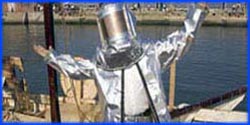


Premier Date: April 27, 2011
plausible
In a small-scale test of buoyancy in bubbling water, Adam built a crude hydrometer, weighted to float at a certain height, and placed it in a fish tank full of water. The device did not sink when air bubbled in, but he and Jamie thought that this was the result of upward water currents. Jamie then built a larger bubbler to place inside a 10,000-gallon tank (previously used in the whirlpool myths). Adam donned a wetsuit and carried enough weights to leave only his head above the surface. When the bubbler was turned on, the upwelling pushed him to one side, where he sank in a downward current.
In order to eliminate these wall effects, Adam and Jamie built a 4-by-16-foot bubbler to place at the bottom of a swimming pool. After they added weights to keep the rig from floating up, Adam tried to swim across the pool and back through the bubbles. The trip proved difficult at 25% power and impossible at 100%. Adam and Jamie classified the myth as plausible, but for a different reason from the one expected — water currents holding the swimmer at the surface, rather than a loss of buoyancy due to the air bubbles.
busted
To simulate a real tree, the Build Team dug a hole in the ground and stood a 20-foot, 6,000-pound (pine log in it. They set up a remote-controlled rig to fire an arrow fitted with a binary explosive charge equivalent to a stick of dynamite. Tests with a single and double charge failed to damage the log, so they stuck an arrow into the wood by hand and attached six charges. This attempt also did not result in a split; Grant commented that the placement of the explosive outside the tree surface prevented its force from being channeled into the wood.
Declaring the myth busted, the team did some small-scale tests with different explosives and placement techniques. A TNT charge drilled into the trunk shredded it at the blast point, while an ANFO charge laid in grooves cut along the wood grain caused some degree of splitting.
In one last full-scale test, the team chose a 100-foot Ponderosa pine and fitted it with 25 pounds of ANFO, laid in grooves cut near the core. The resulting blast tore the tree into hundreds of pieces.
Previous: Episode 162: Running on Water